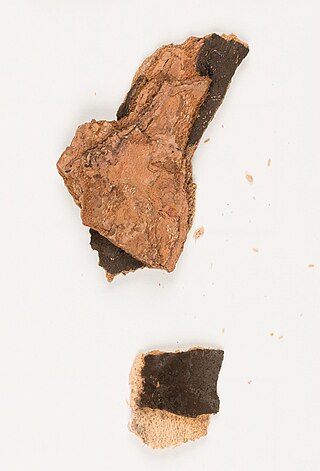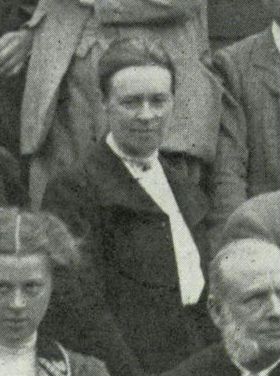
Mycelial cords are linear aggregations of parallel-oriented hyphae. The mature cords are composed of wide, empty vessel hyphae surrounded by narrower sheathing hyphae. Cords may look similar to plant roots, and also frequently have similar functions; hence they are also called rhizomorphs. As well as growing underground or on the surface of trees and other plants, some fungi make mycelial cords which hang in the air from vegetation.

Mycocentrospora acerina is a deuteromycete fungus that is a plant pathogen.
Penicillium echinulatum is a mold species in the genus Penicillium. It is a source of cellulase.

Cryptostroma corticale is a species of fungus that causes sooty bark disease of maples, particularly sycamore. The spores grow profusely under the bark of affected trees or stacked logs. The fungus causes disease and death in trees, and the spores are allergenic and cause a debilitating pneumonitis in humans.
George Smith was a British mycologist. Born in Great Harwood, he graduated from the University of Manchester in 1916 with first-class honours, and received his Master's degree in chemistry two years later. After starting a laboratory with the textile manufacturing company Boardman and Baron Ltd. in 1919, he began to study the mildew and moulds that grew on goods made from cotton.
Penicillium clavigerum is a fungus species of the genus of Penicillium which produces fumigaclavine A and fumigaclavine B
Penicillium dimorphosporum is an anamorph species of the genus of Penicillium.
Penicillium isariiforme is an anamorph, phototropic species of the genus of Penicillium which produce secalonic acid D and F.
Penicillium janczewskii is an anamorph and filamentous species of the genus of Penicillium which was isolated from the rhizosphere of Vernonia herbacea. Penicillium janczewskii produces griseofulvin
Penicillium allahabadense is an anamorph species of the genus of Penicillium which produces rugulosin.

Gulielma Lister was a British botanist and mycologist, and was considered an international authority on Mycetozoa.

Exserohilum is a genus of fungi in the family Pleosporaceae. The Exserohilum species are known for causing blight and human immune system diseases. The sexual reproductive states of Exserohilum species are known as Setosphaeria. The type species is Exserohilum turcicum. This genus is among three dematiaceous that are categorized for containing pathogens leading to diseases like phaeohyphomycosis.
Penicillium raistrickii is an anamorph species of fungus in the genus Penicillium which produces griseofulvin, patulin and verruculogen.
Kathleen Sampson was an English mycologist and plant pathologist, with a focus in herbage crops and cereal diseases. She was a leading authority on smut fungi growing in the British Isles.
Philip Herries Gregory was a British mycologist and phytopathologist. He established an international reputation as a pioneer of aerobiology and a leading expert on the liberation and dispersal of fungal spores and their relation to plant diseases and to human respiratory diseases. In 1957 he was elected to a one-year term as president of the British Mycological Society.
Clarence James Hickman was a British-Canadian mycologist. He is noteworthy for his discovery in 1940 that the oomycete species Phytophthora fragariae is the cause of the disease red stele in strawberry plants.
Elizabeth "Elsie" Marianne Blackwell was an English botanist and mycologist, known as an expert on Phytophthora. She was the president of the British Mycological Society for a one-year term from 1942 to 1943.
John Colhoun was a British mycologist, phytopathologist, and professor of cryptogamic botany. For a one-year term from 1963 to 1964 he was the president of the British Mycological Society.
Samuel Paul Wiltshire was an English mycologist and phytopathologist. For the academic year 1943–1944 he was the president of the British Mycological Society.
Brian Charles Sutton is a British botanist, phytopathologist, mycologist, known as one of the world's leading experts in coelomycete classification. He was the president of the British Mycological Society for the academic year 1985–1986.




